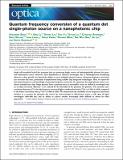Files in this item
Quantum frequency conversion of a quantum dot single-photon source on a nanophotonic chip
Item metadata
| dc.contributor.author | Singh, Anshuman | |
| dc.contributor.author | Li, Qing | |
| dc.contributor.author | Liu, Shunfa | |
| dc.contributor.author | Yu, Ying | |
| dc.contributor.author | Lu, Xiyuan | |
| dc.contributor.author | Schneider, Christian | |
| dc.contributor.author | Höfling, Sven | |
| dc.contributor.author | Lawall, John | |
| dc.contributor.author | Verma, Varun | |
| dc.contributor.author | Mirin, Richard | |
| dc.contributor.author | Nam, Sae Woo | |
| dc.contributor.author | Liu, Jin | |
| dc.contributor.author | Srinivasan, Kartik | |
| dc.date.accessioned | 2019-04-26T16:30:06Z | |
| dc.date.available | 2019-04-26T16:30:06Z | |
| dc.date.issued | 2019-05 | |
| dc.identifier | 258413628 | |
| dc.identifier | ac25d9f6-b3cb-4bb5-8b4b-c9d71e1ce7f7 | |
| dc.identifier | 85067997033 | |
| dc.identifier | 000468373300008 | |
| dc.identifier.citation | Singh , A , Li , Q , Liu , S , Yu , Y , Lu , X , Schneider , C , Höfling , S , Lawall , J , Verma , V , Mirin , R , Nam , S W , Liu , J & Srinivasan , K 2019 , ' Quantum frequency conversion of a quantum dot single-photon source on a nanophotonic chip ' , Optica , vol. 6 , no. 5 , pp. 563-569 . https://doi.org/10.1364/OPTICA.6.000563 | en |
| dc.identifier.issn | 2334-2536 | |
| dc.identifier.uri | https://hdl.handle.net/10023/17594 | |
| dc.description | A. Singh, Q. Li, and X. Lu acknowledge support under the Cooperative Research Agreement between the UMD and NIST-PML. C. Schneider and S. Höfling acknowledge support by the State of Bavaria and the BMBF within the project Q.Com-HL. C. Schneider acknowledges funding by the DFG. | en |
| dc.description.abstract | Single self-assembled InAs/GaAs quantum dots are promising bright sources of indistinguishable photons for quantum information science. However, their distribution in emission wavelength, due to inhomogeneous broadening inherent to their growth, has limited the ability to create multiple identical sources. Quantum frequency conversion can overcome this issue, particularly if implemented using scalable chip-integrated technologies. Here, we report the first demonstration to our knowledge of quantum frequency conversion of a quantum dot single-photon source on a silicon nanophotonic chip. Single photons from a quantum dot in a micropillar cavity are shifted in wavelength with an on-chip conversion efficiency ≈12%, limited by the linewidth of the quantum dot photons. The intensity autocorrelation function g(2)(0) for the frequency-converted light is antibunched with g(2)(0) = 0.290 ± 0.030, compared to the before-conversion value g(2)(0) = 0.080 ± 0.003. We demonstrate the suitability of our frequency-conversion interface as a resource for quantum dot sources by characterizing its effectiveness across a wide span of input wavelengths (840–980 nm) and its ability to achieve tunable wavelength shifts difficult to obtain by other approaches. | |
| dc.format.extent | 7 | |
| dc.format.extent | 1840625 | |
| dc.language.iso | eng | |
| dc.relation.ispartof | Optica | en |
| dc.subject | QC Physics | en |
| dc.subject | TK Electrical engineering. Electronics Nuclear engineering | en |
| dc.subject | NDAS | en |
| dc.subject.lcc | QC | en |
| dc.subject.lcc | TK | en |
| dc.title | Quantum frequency conversion of a quantum dot single-photon source on a nanophotonic chip | en |
| dc.type | Journal article | en |
| dc.contributor.institution | University of St Andrews. Condensed Matter Physics | en |
| dc.contributor.institution | University of St Andrews. School of Physics and Astronomy | en |
| dc.identifier.doi | https://doi.org/10.1364/OPTICA.6.000563 | |
| dc.description.status | Peer reviewed | en |
This item appears in the following Collection(s)
Items in the St Andrews Research Repository are protected by copyright, with all rights reserved, unless otherwise indicated.

